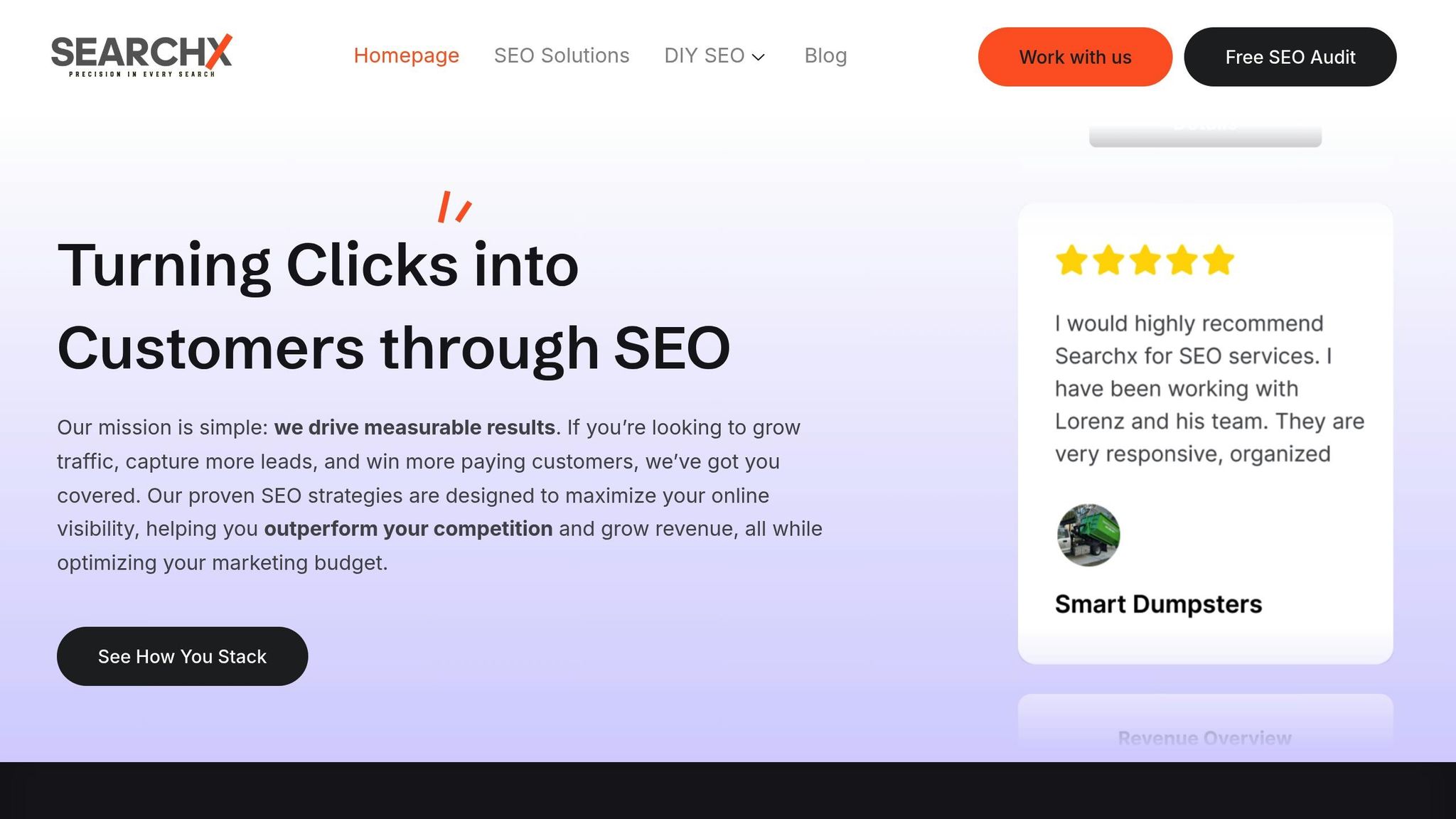Custom SEO dashboards simplify tracking your website’s performance and aligning SEO efforts with business goals. They save time, provide real-time data, and make complex metrics easy to understand. Here’s how to create one:
- Key Metrics to Track: Organic traffic, keyword rankings, click-through rates, conversions, and revenue.
- Tools to Use: Google Looker Studio (free and integrates well with Google tools), Microsoft Power BI (advanced features for enterprises), or Reporting Ninja (ideal for agencies).
- Steps to Set Up:
- Connect data sources like Google Analytics 4 and Google Search Console.
- Organize metrics into sections (e.g., traffic, rankings, technical health).
- Create tailored views for executives, SEO teams, or clients.
- Keep It Updated: Regularly review data accuracy, apply user feedback, and monitor performance shifts.
A good SEO dashboard helps you turn raw data into actionable insights, saving up to 80% of reporting time and boosting results.
Build an SEO Dashboard in Looker Studio (Data Studio)
Step 1: Select Your Key SEO Metrics
Choosing the right metrics is how you measure the success of your SEO efforts.
Basic SEO Performance Metrics
| Metric | What It Measures | Why It Matters |
|---|---|---|
| Organic Traffic | Visitors from search engines | Tracks campaign success |
| Keyword Rankings | SERP positions for target keywords | Shows search visibility |
| Click-Through Rate | Percentage of impressions leading to clicks | Evaluates listing effectiveness |
| Conversions | Completed desired actions | Links SEO to revenue |
While organic traffic is essential, it’s only valuable if it translates into business outcomes. Grouping these metrics makes it easier to analyze trends and performance.
Metric Categories and Groups
Organizing metrics into categories helps simplify your analysis:
Visibility Metrics
- Search impressions
- Keyword rankings
User Behavior Data
- Bounce rate
- Session duration
Technical Performance Indicators
- Site speed
- Crawl errors
Revenue and Business Impact
SEO isn’t just about traffic – it’s about driving results that matter for your business. Metrics should connect to tangible outcomes, like revenue and growth.
"Results Are Counted in Dollars, Not Visitors" – SearchX | SEO Agency
Here are some revenue-focused metrics to track:
- Revenue generated from organic search
- Lead generation (e.g., form submissions, phone calls)
- Customer lifetime value from SEO-driven traffic
- ROI from SEO campaigns
For example, implementing structured data markup can make a big difference. One case study showed a 35% increase in site visits and an 82% jump in click-through rate.
Once you’ve identified your metrics, the next step is to choose dashboard software that makes these numbers easy to understand and act upon.
Step 2: Pick Your Dashboard Software
Once you’ve nailed down your metrics in Step 1, it’s time to choose software that turns your data into actionable insights. The right dashboard software is essential for keeping tabs on your SEO performance and making informed decisions.
Common Dashboard Tools
There are several popular tools for building SEO dashboards, each offering distinct features to suit different needs:
| Tool | Key Features | Best For |
|---|---|---|
| Google Looker Studio | Integrates seamlessly with GA4 and Google Search Console; Free to use; Customizable visualizations | Small to medium businesses |
| Microsoft Power BI | Advanced data modeling; Complex visualizations; Enterprise-grade features | Large organizations |
| Reporting Ninja | White-label reporting; Connects to multiple data sources; Automated updates | Agencies and client reporting |
Google Looker Studio stands out for its easy integration with Google tools, making it a go-to choice for consolidating SEO data into detailed, easy-to-read reports.
Software Selection Checklist
When assessing dashboard tools, here are some key factors to consider:
Data Integration Capabilities
- Supports direct connections to your SEO tools
- Offers API access for custom data sources
- Includes real-time data refresh options
Scalability Features
- Allows user access controls
- Offers dashboard templates for quick setup
- Handles large datasets without performance issues
Cost Considerations
- Look into initial setup fees
- Compare monthly subscription costs
- Check if pricing is based on the number of users
SearchX Dashboard Tools

SearchX provides a dashboard solution tailored for SEO performance tracking, offering features designed to streamline your reporting process:
Performance Monitoring
- Real-time keyword position updates
- Insights into traffic trends
- Conversion tracking to measure results
Reporting Features
- Custom-branded reports for a professional touch
- Automated updates to keep data fresh
- Optimized for use across multiple devices
A good SEO dashboard doesn’t just display numbers – it helps you make decisions based on the data. If you’re just starting out, a free option like Google Looker Studio is a solid choice. As your needs grow, you can explore more advanced tools that offer additional flexibility and features.
sbb-itb-880d5b6
Step 3: Set Up Your Dashboard
Follow these steps to set up an SEO dashboard that delivers the insights you need.
Connect Your Data Sources
Start by linking your primary data sources to ensure your dashboard captures all the essential SEO metrics.
1. Google Analytics 4 (GA4)
Integrate GA4 by selecting your property, verifying your account, and granting the necessary permissions. This connection lets you track organic traffic, conversions, and other key performance indicators.
2. Google Search Console
Link Google Search Console to monitor keyword performance and crawl data. Make sure you have admin access and select the correct property to avoid connection issues.
Once your data sources are connected, you’re ready to design a dashboard layout that prioritizes the metrics that matter most.
Create Your Layout
A well-organized layout ensures your dashboard is easy to navigate and provides actionable insights. Here’s a suggested structure:
| Section | Key Metrics | Visualization Type |
|---|---|---|
| Top KPIs | Organic traffic, Conversions, Revenue | Scorecards with trend indicators |
| Traffic Analysis | Source breakdown, Landing pages | Line charts, Bar graphs |
| Rankings | Keyword positions, SERP features | Tables with filters |
| Technical Health | Core Web Vitals, Crawl status | Gauge charts, Status indicators |
Organize your layout so it flows logically – from high-level metrics like KPIs at the top to detailed data further down. This way, the most critical insights are immediately visible.
Adjust for Different Users
Tailor the dashboard to meet the needs of various users. SearchX emphasizes creating views that are specific to the audience:
Executive View
- Highlights revenue impact and ROI
- Includes trend visualizations
- Offers year-over-year comparisons
SEO Team View
- Focuses on technical metrics
- Tracks campaign performance
- Displays daily ranking updates
Client View
- Provides custom-branded reports
- Tracks progress toward goals
- Uses simple, easy-to-understand visuals
To make the dashboard even more user-friendly, add tooltips or brief notes explaining complex metrics. For instance, include a quick description of Core Web Vitals scores or clarify how ranking changes influence overall SEO performance.
Step 4: Update and Improve
Keep your SEO dashboard fresh and relevant to maintain its value in guiding decisions.
Check Data Accuracy
Make sure your data is reliable by following a consistent schedule for reviews:
| Frequency | Check Type | Key Actions |
|---|---|---|
| Weekly | Quick Audit | • Ensure data feeds are working • Check for tracking code issues • Review major metric changes |
| Monthly | Detailed Review | • Cross-check data from different sources • Validate conversion tracking accuracy • Update goal settings |
| Quarterly | Comprehensive Audit | • Inspect all data connections • Revisit metric definitions • Remove outdated widgets |
Apply User Feedback
Use built-in forms or regular check-ins to gather user input. Then, prioritize updates based on effort and impact:
- High Impact, Low Effort: Rename widget labels, reorganize sections, or add helpful tooltips.
- High Impact, High Effort: Add new data sources, create custom calculations, or automate reporting processes.
Keep users informed about updates by documenting changes and sending notifications. This helps them adapt easily and focus on tracking performance improvements.
Monitor Changes and Issues
Once updates are implemented, keep a close eye on how they perform. Set up tracking protocols to catch any issues early and ensure your dashboard supports ongoing SEO success:
Ranking Changes:
- Get alerts for drops of more than three positions.
- Track wins and losses in featured snippets.
- Keep tabs on competitor rankings.
Technical Issues:
- Monitor Core Web Vitals.
- Check for crawl errors and coverage issues.
- Address mobile usability problems promptly.
Performance Shifts:
- Watch for unusual traffic patterns.
- Identify sudden changes in conversion rates.
- Assess how organic search impacts revenue.
"You’ll always know where your campaign stands. With real-time dashboards and regular updates, we keep you in the loop, so you’re never left wondering about your progress." – SearchX
Leverage automated monitoring tools to track these metrics and set custom alerts for significant changes. This proactive approach ensures you can respond quickly to any challenges.
Conclusion: Build Better SEO Reports
By following the steps outlined above – choosing the right metrics, selecting reliable software, setting up dashboards, and refining them over time – you create a strong foundation for effective SEO reporting. A well-designed SEO dashboard isn’t just a tool; it’s a strategic asset that helps businesses streamline processes and focus on what truly matters. In fact, companies using tailored SEO dashboards have reported up to 1,000% more traffic and increased productivity by cutting out manual data collection and concentrating on key performance indicators.
The best dashboards are built on three essential principles:
1. Align with Business Goals
Your dashboard should bridge the gap between SEO efforts and measurable business outcomes, such as revenue growth or customer acquisition. Focus on metrics that impact decision-making and clearly demonstrate ROI.
2. Ensure Data Accuracy
Consistently validate your data sources to make your dashboard dependable for strategic decisions. Experts highlight that combining multiple data sources while maintaining accuracy provides a more complete picture of SEO performance.
3. Adapt to Change
As SEO continues to evolve – with trends like AI-driven insights and geo-targeting becoming more prominent by 2025 – your dashboard should evolve too. Staying flexible ensures that your reporting remains actionable and relevant as the landscape shifts.
"We’re relentless in our pursuit of success and adjust strategies based on what’s getting you results – whether that’s new tactics, shifting focus, or doubling down on winning strategies." – SearchX
SearchX tools simplify the process with real-time updates and automated tracking, making it easier to monitor critical SEO metrics. Whether you’re managing a local SEO campaign or overseeing operations across multiple locations, a well-organized dashboard helps you spot opportunities and address issues quickly.
The key to a successful dashboard is finding the balance between detailed data and clear, digestible presentation. By applying these principles, you can turn raw numbers into actionable insights that drive business growth.
FAQs
What makes custom SEO dashboards better than traditional reporting methods?
Custom SEO dashboards bring a fresh approach to tracking performance by offering personalized insights that match your business objectives. Unlike static reports, these dashboards let you monitor real-time data, hone in on the KPIs that matter most to your strategy, and spot opportunities or challenges as they arise.
Another major perk? They save time. By automating data collection and visualization, you can skip the hassle of manual updates. Tools like those from SearchX make it easier to build scalable solutions that simplify your SEO processes and deliver actionable results.
How do I keep my SEO dashboard data accurate and up-to-date?
To keep your SEO dashboard accurate and up to date, it’s essential to connect dependable data sources and set up regular updates. Opt for tools that sync automatically with platforms like Google Analytics, Google Search Console, or other SEO tools to reduce the chances of manual mistakes.
It’s also a good idea to periodically check your data sources to ensure they align with your current business objectives. If you’re working with custom metrics, double-check that they’re calculated properly and reflect the latest SEO trends or algorithm updates. Performing regular audits of your dashboard settings and data inputs can go a long way in maintaining accuracy over time.
What factors should I consider when selecting dashboard software for my SEO needs?
When selecting dashboard software to support your SEO efforts, keep these key considerations in mind:
- Customization Options: The tool should let you design dashboards that align with your unique business objectives and track the metrics that matter most to you.
- Integration Capabilities: Opt for software that easily connects with tools you’re already using, such as Google Analytics, Search Console, or even social media platforms.
- Ease of Use: A user-friendly interface is crucial. It should make visualizing and reporting data straightforward, even for team members who aren’t data experts.
- Scalability: As your business grows, your data needs will expand. Choose a solution that can handle increasing demands without a hitch.
Focusing on these aspects will help you find a dashboard tool that not only supports your SEO strategy but also delivers insights that can drive meaningful progress.




